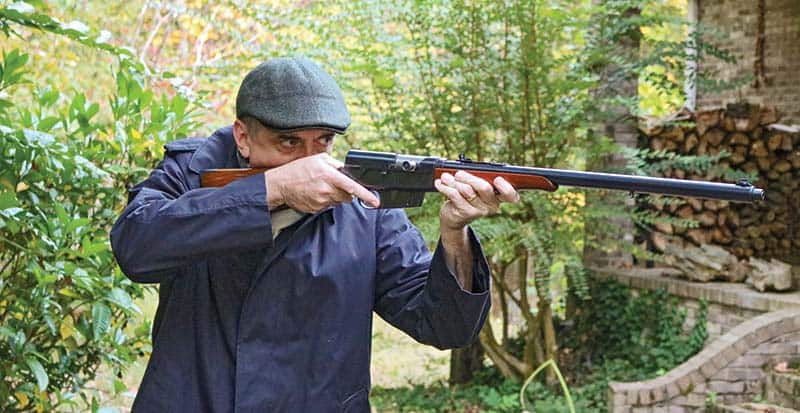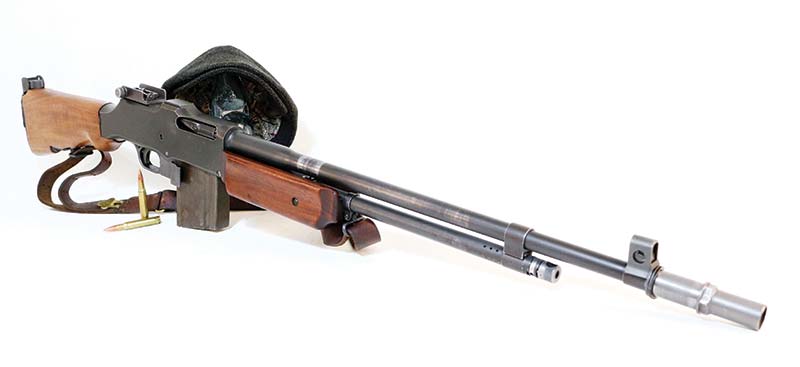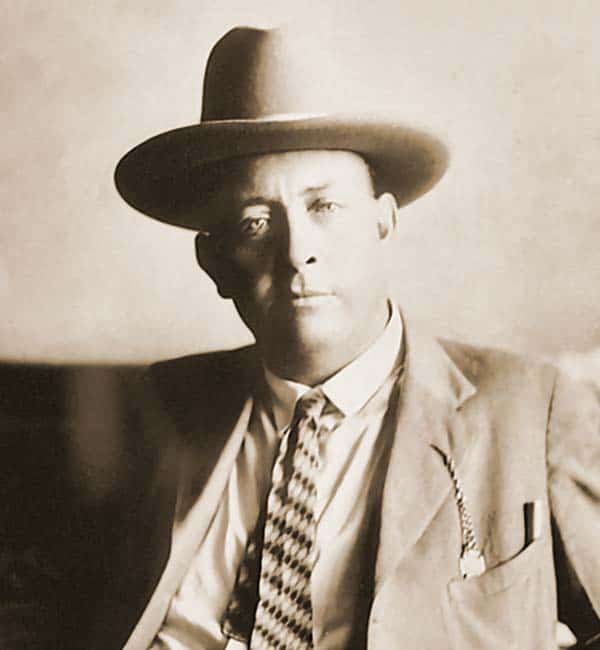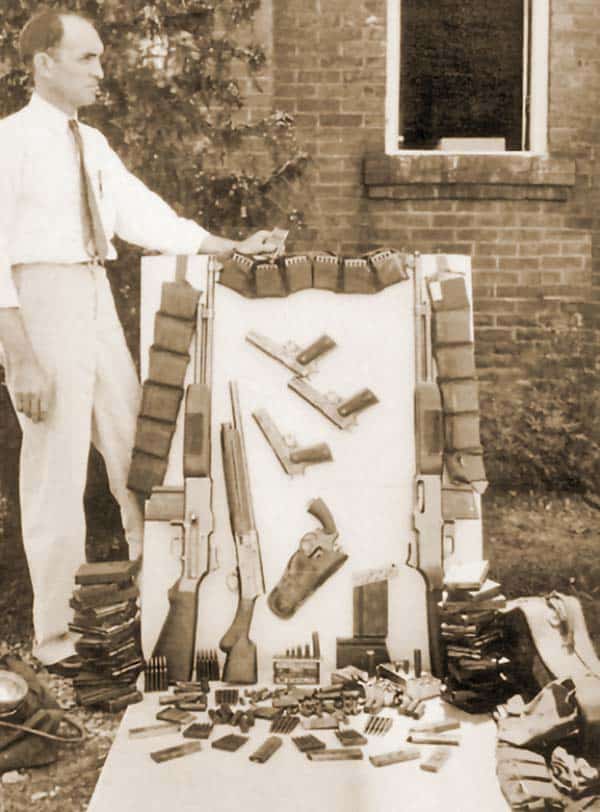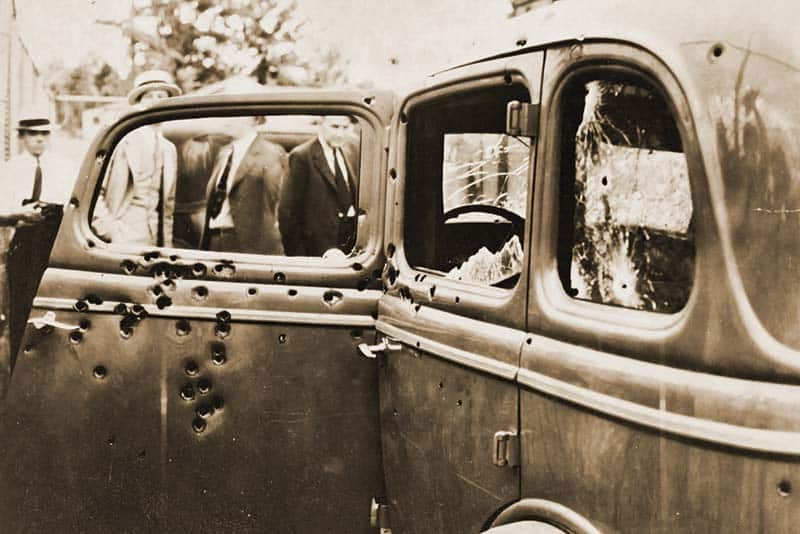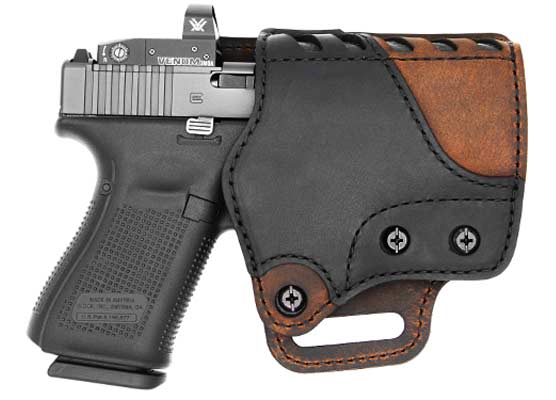Hamer's Hammer
Break Glass In Case Of War
May 23, 1934 was a Wednesday. The National Firearms Act of 1934, the first serious federal gun control law in American history, would take effect in 34 days. It was a warm, clear morning in rural Louisiana. Along a deserted stretch of State Highway 154 just south of Gibsland in Bienville Parish, a heterogeneous group of half a dozen heavily armed lawmen drawn from a variety of agencies maintained a miserable vigil amongst the nearby brush. The cops had been in place amidst the heat and the bugs for two full days.
They heard the car before they saw it. The 1934 Ford V-8 was one of the fastest, most powerful production sedans on the road. With a powerplant producing a breathtaking 85-horsepower, this Ford Fordor Deluxe had recently been stolen from Jesse and Ruth Warren. Though the car left the factory Cordoba Gray, its new owners had supposedly repainted it desert tan to befuddle pursuers.
Behind the wheel was Clyde Champion Barrow, 25-year-old bank robber and professional homicidal psychopath. Riding shotgun was his cute 23-year-old paramour, Bonnie Elizabeth Parker. Over the course of two frenetic years, the legendary star-crossed lovers had accounted for at least 13 murders, nine of whom were police officers. On this brilliant Louisiana morning, Bonnie and Clyde had a date with Frank Hamer.
The Shooters
Two of the cops were from Louisiana, while the remaining four hailed from Texas. Leading the pack was a living legend named Frank Hamer. Frank Hamer was indeed one stone-cold lawman.
Born in 1884, the son of a blacksmith in Fairview, Texas, Francis Augustus Hamer was raised a devout Presbyterian. All but one of the five Hamer boys eventually became Texas Rangers. Raised in Oxford, Texas, in Llano County, Hamer later described himself as the only “Oxford-educated Ranger” in Texas.
Hamer dropped out of school in Sixth Grade to help out in his father’s blacksmith shop. Despite his dearth of formal education, Hamer had a photographic memory and a superhuman drive. He was shot for the first time at age 16 with a load of 12-gauge buckshot. At age 21 he made a citizen’s arrest of a horse thief and found he had a knack for it.
What followed was fully four decades in Law Enforcement. Frank served both with the Rangers as well as other LE agencies as the spirit led. Hamer killed his first criminal, a proper villain named Ed Putnam, while the miscreant was seeking refuge in a brothel. Hamer dropped the murderer with a single round below the eye from his Winchester Model 94 lever-action rifle. Oddly for this time and place, Putnam was carrying a German Luger pistol when he was killed.
Hamer engaged in a long-term crusade against the KKK. Over the course of his protracted career, Hamer rescued 15 African-American men from various lynch mobs. The Bonnie and Clyde hit, however, was Frank Hamer’s masterwork.
Hamer was brought out of retirement to hunt the two young killers. Along with his lifelong friend Maney Gault, Hamer tracked the pair across the American South. Gault was an old soul who was later described to be “As taciturn as a turtle in a drought.” Hamer’s mandate prior to taking this curious job was, “Put ’em on the spot, know you’re right — and shoot everybody in sight.” For this job he needed a specific weapon.
The various members of Hamer’s posse carried an assortment of rifles as well as shotguns and personal sidearms. Dallas County Deputy Sheriff Ted Hinton even packed a shortened Colt Monitor BAR borrowed from the Texas National Guard, one of only 130 or so produced. On this bright morning in May, 1934, Frank Hamer carried a Remington Model 8 chambered in .35 Auto. When Bonnie and Clyde slowed their Ford V-8 in response to a ruse orchestrated by Hamer, which included the couple’s erstwhile friend, Ivy Methvin, everyone made ready.
The Hit
The accumulated posse had discussed this moment in detail in advance. The previous year a lawman named Smoot Schmid had confronted the pair with the nasty end of a Thompson submachine gun and commanded they halt. He received a burst of gunfire for his trouble. Considering the impressive tally of dead cops the two lovers left in their wake, the accumulated Law Enforcement shooters were not feeling terribly convivial.
There is some controversy regarding the details, but legend has it Frank Hamer likely initiated the ambush himself with a single shot from his Model 8. The round punched through the V-8’s windshield and struck Clyde Barrow in the side of the head, killing him instantly. The rest of his team opened up on cue, ultimately emptying their long guns, their shotguns and their personal sidearms, absolutely riddling both the car and its occupants.
The lawmen fired some 160 rounds over about 16 seconds, 112 of which connected with the car. Roughly one fourth struck flesh. Clyde suffered 17 entrance wounds, while Bonnie had 26. The undertaker later reported he had difficulty embalming the bodies as the fluid kept leaking out.
What followed was a macabre display of mankind’s innate inhumanity. Once word got out the pair was dead, gawkers flocked in from all over. One woman fresh on the scene produced a pen knife and began cutting bloody locks of Bonnie’s hair along with scraps of her blood-soaked dress away for souvenirs. The cops stopped a man before he could remove Clyde’s ear and trigger finger as keepsakes. The shell casings, shattered glass and bloody bits of clothing were all snatched up in short order.
Hamer and his posse recovered a variety of weapons from the ventilated vehicle. There were seven .45 Colt 1911 pistols, one .32 caliber M1903 Colt automatic pistol, one sawed-off 20-gauge Remington Model 11 shotgun purportedly favored by the petite Bonnie, three .30-06 Browning Automatic rifles, one double-action Colt M1909 revolver, one sawed-off 10-gauge Winchester 1901 lever-action shotgun, one .25ACP Colt automatic pistol, and one .38-caliber Colt Detective Special revolver. They also found 100 loaded BAR magazines and another 3,000 rounds of assorted ammunition.
The Model 8
Frank Hamer’s Remington Model 8 was the first commercially successful autoloading rifle sold on the civilian market. The weapon’s modest weight and fast handling made it a popular cop gun as well. The rifle sported a simply fascinating design.
The Model 8 was yet another remarkable brainchild of John Moses Browning. The common genetic influences shared by such Browning classics as the Auto-5 shotgun are obvious if you look for them. Browning first patented the Model 8 design in 1900 before selling the U.S. production rights to Remington. FN in Belgium marketed a very similar weapon for the international market titled the Model 1900. More than 80,000 copies were produced.
Not unlike the Auto-5, the Model 8 operated via the long recoil system. In this case, the barrel slid rearward inside a drawn steel tube during the firing cycle. The bolt locked to the barrel via a rotating bolt head. The bolt and barrel recoiled back as a single unit when discharged. At the rearmost point of travel the bolt was secured to the rear, while a separate spring system returned the barrel forward to its rest position. This action extracted the empty case. Once the barrel settled back into place, the bolt was released to pick up another round and lock it in position for firing again.
The top of the receiver cover was milled to accept stripper clips. The right-sided ranch gate safety lever was remarkably similar in appearance and function to the Kalashnikov rifle. Given its era, the Model 8 was an exceptionally advanced design.
The Model 8 was offered in .25 Remington, .30 Remington, .32 Remington, .35 Remington and .300 Savage loadings. The five available finish options included Standard, Special, Peerless, Expert and Premiere. My 1914-vintage .32 Rem Model 8 was a serendipitous auction find. I was thrilled to land it at a good price.
Captain Hamer owned several Model 8 rifles, one of which was a heavily engraved version that was a gift from the Remington Company after a shooting exhibition. The customized Model 8 Hamer used in Louisiana that fateful day was serial number 10045 chambered in .35 Remington. Hamer purchased this specific gun through Petmeckey’s Sporting Goods Store in Austin. Hamer had replaced the standard fixed magazine with an extended 20-round version he had obtained through Peace Officers Equipment Company in St. Joseph, Mo.
Denouement
Hamer’s posse had been promised a serious reward for the neutralization of Bonnie and Clyde. However, many of the private businesses pledging funds ultimately reneged. Each member of the team ended up with about $200 or roughly $4,400 today. The half dozen cops did end up keeping the seized criminals’ firearms as war booty.
The posse returned soon thereafter and recreated the shooting at the actual site with the same weapons they used on the hit. Period film of the recreation can be found on YouTube. In it, Frank Hamer flinches when hit with a piece of hot brass.
Clyde’s mother unsuccessfully attempted to have the crime guns returned to her. She claimed as her son had never been convicted of a crime, the weapons were still her son’s property. Considering all of the weapons were stolen, many from National Guard armories, it was a bold though ultimately unsuccessful move.
Like many of his era, Frank Hamer lived a hard life. He was a heavy smoker who suffered a stroke in 1953 at age 69. The legendary lawman died two years later. At the time of his death, Hamer had been shot 17 times and left for dead after shootouts with criminals on at least four occasions. He had killed somewhere between 53 and 70 people in the line of duty.
Frank Hamer was the product of a different time. Not unlike General George Patton during World War II, such a flamboyant personality would not have lasted long in today’s woke environment. However, in 1934 during the era of the notorious motorized bandit, Frank Hamer was the man the country needed for the gory task at hand. He was a “Break Glass In Case Of War” sort of policeman.
